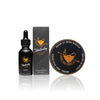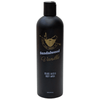Beard oil is by far one of the most popular beard care products available on the market today. If you've got a beard, chances are that you've either already got a few bottles of beard oil knocking around in your bathroom cabinet - or are strongly considering buying some.
However, is beard oil safe for your facial hair and the skin underneath? Let's take a look.
Beard oil is safe for use when made by reputable brands that put their products through cosmetic testing. However, cheap products have been known to use ingredients like essential oils, and harsh synthetic fragrance oils, at unsafe levels. This can cause skin reactions and other nasty side effects.
Beard Oil Safety: Beard oils are generally safe when purchased from reputable brands, but low-quality products can cause side effects due to harsh ingredients.
Common Side Effects: Potential side effects include allergic reactions, itching, inflammation, eye irritation, and phototoxicity from certain essential oils.
Avoiding Side Effects: To prevent issues, buy quality beard oils, follow recommended usage, avoid over-application, and patch-test new products.
Importance of Proper Usage: Use the correct amount of beard oil to avoid clogged pores, and skin irritation, and ensure the product fully absorbs within 20-30 minutes.
Table of Contents
5 Side Effects of Beard Oil to Keen an Eye Open for

1. Allergic reaction
Many beard growth oil brands (including us) use all-natural products, as these are often better for your skin than synthetic fragrance oils and chemicals.
However, what people sometimes don't realise is that natural oils, specifically essential oils, can contain allergens. You don't just need a pre-existing allergy to a certain ingredient to get a reaction - if a beard oil contains too much of a particular essential oil, it can cause problems for your skin.
One 2012 case study review identified the following essential oils as most likely to cause allergic reactions:
Tea pe
Peppermint
Ylang-ylang
Lavender
Additionally, a 2010 review of patch test samples named sandalwood and clove oil as likely to cause allergic reactions if used in too high quantities.
2. Itching, or contact dermatitis
Some beard growth oils can cause your beard and skin beneath to feel itchy and uncomfortable, hampering growth.
But wait - isn't beard oil meant to cure beard itch and dry skin and support facial hair growth?
Yes, it is. However, harsh synthetic fragrances - or natural oils included in too high a quantity - can actually make your beard itchier.
This is known as contact dermatitis, and it's your skin's way of saying "I'm not used to this and I don't like this".
Contact dermatitis can take a few days to present, meaning beard oil users can fall into the trap of thinking the oil is working for the first 24-48 hours, then thinking they're not using enough when itching starts to present.
As a general rule, always patch test new cosmetic products (including beard oil and beard balm) to check your skin is ok with them before smothering them all over that beautiful beard.
3. Inflammation
Beard oil is brilliant for your facial hair. However, use too much, and you could do more harm than good.
How? Because your skin can only use so much, and if you over-apply beard oil, you run the risk of clogging your pores. Clogged pores can cause acne, inflammation and dry skin, which can leave your beard feeling unhealthy and uncomfortable.
To avoid excess oil build-up:
use beard oil in line with recommended quantities
brush your facial hair at least once a day with a suitable beard brush to distribute beard oil and help unclog pores
wash your beard with a specialist beard shampoo (don't use normal head shampoo)
If you follow these steps and still notice inflammation, potentially look for a product containing carrier oils like jojoba oil. Not only does this closely mimic your skin's natural oil, making it great for beard hair, it also absorbs incredibly easily.
4. Eye irritation
It's called beard oil for a reason - it's meant for beards, not eyes.
While beard oil is great at fixing dry, itchy beards, it's going to do the opposite for your eyes. If you're prone to touching your beard and rubbing your face, it's only a matter of time before you get a bit of beard oil in your eye. When this happens, you might notice some dryness and irritation.
This is particularly likely in the evening if you apply oil before bed, as your pillow can push your oil into your eyes. If you're experiencing eye discomfort, wash them immediately with warm water and follow the guidance on your beard oil box if provided.
Remember - if your hands come away shiny from rubbing your beard 30 minutes after you applied beard oil, you've used too much. A good beard oil should fully absorb into your hair and skin within 20-30 minutes.
5. Phototoxicity
This one sounds scary - and it kind of is. Some essential oils found in beard oils are phototoxic, meaning if they're left on your skin and put in direct sunlight, they can cause a reaction.
Popular phototoxic essential oils used in beard oil include:
Lemon
Lime
Orange
Bergamot
As mentioned above, if you're buying your beard oil from a reputable brand, these risks will be ruled out during cosmetic testing. However, be sure to follow the recommended usage on the back of your beard oil bottle/box to reduce the risk of side effects.
What can you do to avoid beard oil side effects?
Take the following steps to reduce the risk of beard oil side effects:
1. Buy from brands you trust
We're looking at you, $4 bottles of beard oil on Amazon. To reduce the risk of side effects, always buy from reputable brands you trust and be willing to spend a little more to ensure quality. It's going on your face, so the standard of the ingredients matter.
2. Follow recommended usage
Most beard oils are safe for use in the morning and evening each day and you shouldn't run into any problems if you do so. However, follow the recommended usage instructions when applying beard oil and be careful not to use too much, as this can increase the allergens the skin beneath your beard comes into contact with. This is especially important if you have sensitive skin.
3. Always check the expiry date
While some synthetic ingredients will still be around at the next dawn of man, natural ingredients don't last that long.
Most beard oils are good for 6-12 months after opening, and this should be denoted by a small symbol on the back of your bottle. Make sure your beard oil is tightly sealed after use, and store it in a cool, dark place out of direct sunlight.
4. Patch test, patch test, patch test
And we'll say it again - patch test! When you get a new beard oil, apply a small amount of it to your skin and leave it there, without touching it or rubbing it. Leave it for a full day to check for any potential reactions.


